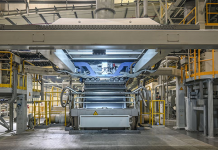Cosmo Films, a global leader in speciality films for flexible packaging, lamination and labeling applications as well as synthetic paper, has announced installation of a new solvent-less lamination machine at its Karjan plant, Vadodara. The new machine has been commissioned at the company’s existing facility at Karjan, near Vadodara, India which already houses BOPP lines, extrusion coating and chemical coating lines, and a metalizer. The installed machine is a Nordmeccanica product, which is 1.8 meter wide and can run up to 450 m/min speed. The machine can produce multilayer film laminates in any thickness and go as thick as 450 microns. The laminate could be a combination of different materials such as PP, PET, PE, nylon, aluminum foil or paper. A dedicated sheet cutter of the same width has also been installed next to the machine to process its output.
As the machine can laminate structures as thick as 450 microns, it would help the company serve customers requiring thick film laminates. Some of the application areas of thick laminates include graphic arts, baggage tags, retort and stand-up pouches, high-strength hanging labels, aseptic boxes and luncheon trays, composites for construction and auto-segment, etc. The machine will also help the company with R&D testing during new product development process.
Speaking on the development, Pankaj Poddar, chief executive officer, Cosmo Films said, “Solvent-less lamination machine is the latest addition to our R&D portfolio. It is also beneficial for customers having thick lamination needs. Solvent-less lamination being an eco-friendly process with no emissions and low energy demands would also help us with our sustainability goals.”
Solvent-less lamination process
The adhesives used in the solvent-less lamination process do not contain solvents. Solvent-less adhesive is a specific type of adhesive composed by two components reacting with each other and consequently not requiring drying. The two components of the adhesives are mixed first and then applied to the film by roll coating method. The two components react with each other on the film web itself without any heat or radiation. The ratio of these components is important for polymerization, which consequently decides the rate of curing and bond strength. Low viscosity of these two components allows easy coating on the film. Initially, the adhesive lends a very low green bond but within a span of 24 hours the adhesive gets cured and develops strength.










